Axial Compression Damage Model and Damage Evolution of Crumb Rubber Concrete Based on the Energy Method
Abstract
1. Introduction
2. Materials and Methods
2.1. Material
2.2. Experiment and Testing Methods
3. Energy Absorption of Crumb Rubber Concrete
3.1. Pre-Crack Energy
3.2. Crack Energy
3.3. Post-Crack Energy Absorbed in Compression
3.4. Total Energy Absorption during Compression
4. Establishing the Damage Model Based on the Energy Method
4.1. Establishment of the Damage Model
4.2. Analysis of Model Parameters
5. Damage Evolution Law of Crumb Rubber Concrete
6. Discussion
7. Conclusions
- With the increase in rubber particle dosage, the pre-cracking energy, cracking energy, and total energy absorbed by the rubber concrete increase and then decrease, while the energy absorption capacity after cracking gradually decreases. The changing trend in the total energy absorption during the compression of the crumb rubber concrete is consistent with the changing trend in the damage dissipation energy .
- The Guo Zhenhai damage model based on the energy method more accurately describes the entire stress–strain curve of the crumb rubber concrete, and the brittleness characteristics of the model parameters and brittleness index remain consistent.
- There are similarities between the two rubber concrete damage evolution patterns based on the energy method, and both sets of curves monotonically increase from 0 in an “S” shape. When the strain reaches the plastic strain stage, the damage development rate of ordinary concrete exceeds that of rubber concrete, and the maximum damage development rate is higher than that of crumb rubber concrete.
Author Contributions
Funding
Data Availability Statement
Conflicts of Interest
References
- Lin, Q.; Liu, Z.; Yu, L.; Zhou, Y.; Cui, Y. Mechanical properties of emulsified asphalt rubber concrete. Acta Mater. Compos. Sin. 2023, 40, 1560–1568. [Google Scholar]
- Lin, Q.; Liu, Z.Q.; Sun, J.L.; Yu, L. Comprehensive modification of emulsified asphalt on improving mechanical properties of crumb rubber concrete. Constr. Build. Mater. 2023, 369, 12. [Google Scholar] [CrossRef]
- Ren, F.M.; Mo, J.X.; Wang, Q.; Ho, J.C.M. Crumb rubber as partial replacement for fine aggregate in concrete: An overview. Constr. Build. Mater. 2022, 343, 24. [Google Scholar] [CrossRef]
- Su, T.; Wang, T.; Zhang, Z.; Sun, X.; Gong, S.; Mei, X.; Tan, Z.; Cui, S. Mechanical properties and frost resistance of recycled brick aggregate concrete modified by nano-SiO2. Nanotechnol. Rev. 2023, 12, 20230576. [Google Scholar] [CrossRef]
- Xue, G.; Fu, Q.; Xu, S.; Li, J.J. Macroscopic mechanical properties and microstructure characteristics of steel slag fine aggregate concrete. J. Build. Eng. 2022, 56, 17. [Google Scholar] [CrossRef]
- Benazzouk, A.; Murzeb, K.; Doyen, G.; Goullieux, A.; Quéneudec, M. Effect of rubber aggregates on the physico-mechanical behaviour of cement-rubber composites-influence of the alveolar texture of rubber aggregates. Cem. Concr. Compos. 2003, 25, 711–720. [Google Scholar] [CrossRef]
- Asgharzadeh, S.M.; Sadeghi, J.; Peivast, P.; Pedram, M. Fatigue properties of crumb rubber asphalt mixtures used in railways. Constr. Build. Mater. 2018, 184, 248–257. [Google Scholar] [CrossRef]
- Ling, T.C. Effects of compaction method and rubber content on the properties of concrete paving blocks. Constr. Build. Mater. 2012, 28, 164–175. [Google Scholar] [CrossRef]
- Ouyang, X.; Wu, Z.M.; Shan, B.; Chen, Q.; Shi, C.J. A critical review on compressive behavior and empirical constitutive models of concrete. Constr. Build. Mater. 2022, 323, 21. [Google Scholar] [CrossRef]
- He, J.R.; Gao, R.F.; Tang, Z.Y. A data-driven multi-scale constitutive model of concrete material based on polynomial chaos expansion and stochastic damage model. Constr. Build. Mater. 2022, 334, 15. [Google Scholar] [CrossRef]
- Li, D.D.; Yan, Z.G.; Gravina, R.; Mills, J.E. Compressive stress strain behavior of crumb rubber concrete (CRC) and application in reinforced CRC slab. Constr. Build. Mater. 2018, 166, 745–759. [Google Scholar] [CrossRef]
- Elzeadani, M.; Bompa, D.V.; Elghazouli, A.Y. Experimental assessment and constitutive modelling of rubberised One-Part Alkali-Activated concrete. Constr. Build. Mater. 2022, 353, 27. [Google Scholar] [CrossRef]
- Zhang, Y.; Zhang, S.Q.; Zhao, W.G.; Jiang, X.; Chen, Y.B.; Hou, J.X.; Wang, Y.C.; Yan, Z.G.; Zhu, H.H. Influence of multi-scale fiber on residual compressive properties of a novel rubberized concrete subjected to elevated temperatures. J. Build. Eng. 2023, 65, 20. [Google Scholar] [CrossRef]
- Dong, S.; Zhao, Q.H.; Zhu, H. Mechanical properties and constitutive model of steel fiber-reinforced rubberized concrete. Constr. Build. Mater. 2022, 327, 21. [Google Scholar] [CrossRef]
- GB50010-2010; Code for Design of Concrete Structures. National Standards of the People’s Republic of China: Beijing, China, 2010.
- Abbara, A.A.; Abdelhalim, A.; Al-Ajamee, M.; Ahmed, O.; Adhikary, S.K.; Ahmed, M. Uniaxial compressive stress-strain relationship for rubberized concrete with coarse aggregate replacem ent up to 100%. Case Stud. Constr. Mater. 2022, 17, e01336. [Google Scholar] [CrossRef]
- Bompa, D.V.; Elghazouli, A.Y.; Xu, B.; Stafford, P.J.; Ruiz-Teran, A.M. Experimental assessment and constitutive modelling of rubberised concrete materials. Constr. Build. Mater. 2017, 137, 246–260. [Google Scholar] [CrossRef]
- Li, L.J.; Ruan, S.H.; Zeng, L. Mechanical properties and constitutive equations of concrete containing a low volume of tire rubber particles. Constr. Build. Mater. 2014, 70, 291–308. [Google Scholar] [CrossRef]
- Pan, D.P. Constitutive Research of Crumb Rubber Concrete. Master’s Thesis, Guangdong University of Technology, Guangzhou, China, 2006. [Google Scholar]
- Cui, X.S.; Guo, Q.; Wu, H. Analysis of Damage of Rubber Concrete in Freezing-thawing Circumstance. Chongqing Jiaotong Univ. 2018, 37, 40–45. [Google Scholar] [CrossRef]
- Zhu, X.B.; Miao, C.W.; Liu, J.P.; Hong, J.X. Influence of crumb rubber on frost resistance of concrete and effect mechanism. Procedia Eng. 2012, 27, 206–213. [Google Scholar] [CrossRef]
- Wen, J.; Su, Y.W. Frost resistance and damage degradation model of polypropylene fiber rubber concrete. New Build. Mater. 2022, 49, 54–59. [Google Scholar]
- Gonen, T. Freezing-thawing and impact resistance of concretes containing waste crumb rubbers. Constr. Build. Mater. 2018, 177, 436–442. [Google Scholar] [CrossRef]
- Zhu, R.N.; Pang, J.Y.; Wang, T.Y. Effect of chloride erosionon mechanical properties damage of rubber concrete. Mine Constr. Technol. 2020, 41, 21–25. [Google Scholar] [CrossRef]
- Xu, J.; Niu, X.L.; Yao, Z.Y. Mechanical properties and acoustic emission data analyses of crumb rubber concrete under biaxial compression stress states. Constr. Build. Mater. 2021, 298, 15. [Google Scholar] [CrossRef]
- Xu, J.; Shu, S.R.; Han, Q.H.; Liu, C. Experimental research on bond behavior of reinforced recycled aggregate concrete based on the acoustic emission technique. Constr. Build. Mater. 2018, 191, 1230–1241. [Google Scholar] [CrossRef]
- Xu, J.; Houndehou, J.D.; Wang, Z.Y.; Ma, Q. Experimental investigation on the mechanical properties and damage evolution of steel-fiber-reinforced crumb rubber concrete with porcelain tile waste. Constr. Build. Mater. 2023, 370, 10. [Google Scholar] [CrossRef]
- Han, Q.H.; Yang, G.; Xu, J.; Fu, Z.W.; Lacidogna, G.; Carpinteri, A. Acoustic emission data analyses based on crumb rubber concrete beam bending tests. Eng. Fract. Mech. 2019, 210, 189–202. [Google Scholar] [CrossRef]
- Zhang, Y.; Zhang, S.Q.; Jiang, X.; Zhao, W.G.; Wang, Y.C.; Zhu, P.H.; Yan, Z.G.; Zhu, H.H. Uniaxial tensile properties of multi-scale fiber reinforced rubberized concrete after exposure to elevated temperatures. J. Clean. Prod. 2023, 389, 17. [Google Scholar] [CrossRef]
- Abouhussien, A.A.; Hassan, A.A.A. Classification of damage in self-consolidating rubberized concrete using acoustic emission intensity analysis. Ultrasonics 2020, 100, 10. [Google Scholar] [CrossRef]
- Karunarathna, S.; Linforth, S.; Kashani, A.; Liu, X.M.; Ngo, T. Effect of recycled rubber aggregate size on fracture and other mechanical properties of structural concrete. J. Clean. Prod. 2021, 314, 13. [Google Scholar] [CrossRef]
- Guo, Y.C.; Zhang, J.H.; Chen, G.M.; Xie, Z.H. Compressive behaviour of concrete structures incorporating recycled concrete aggregates, rubber crumb and reinforced with steel fibre, subjected to elevated temperatures. J. Clean. Prod. 2014, 72, 193–203. [Google Scholar] [CrossRef]
- Abbassi, F.; Ahmad, F. Behavior analysis of concrete with recycled tire rubber as aggregate using 3D-digital image correlation. J. Clean. Prod. 2020, 274, 12. [Google Scholar] [CrossRef]
- Guan, Q.Y.; Xu, Y.Q.; Wang, J.; Wu, Q.Q.; Zhang, P. Meso-scale fracture modelling and fracture properties of rubber concrete considering initial defects. Theor. Appl. Fract. Mech. 2023, 125, 11. [Google Scholar] [CrossRef]
- Guo, Q.; Zhang, R.Y.; Luo, Q.R.; Wu, H.; Sun, H.P.; Ye, Y. Prediction on damage evolution of recycled crumb rubber concrete using quantitative cloud imagine correlation. Constr. Build. Mater. 2019, 209, 340–353. [Google Scholar] [CrossRef]
- JGJ 55-2011; Specification for Mix Proportion Design of Ordinary Concrete. National Standards of the People’s Republic of China: Beijing, China, 2011.
- GB/T50080-2016; Standard for Test Method of Performance on Ordinary Fresh Concrete. National Standards of the People’s Republic of China: Beijing, China, 2016.
- GB/T50081-2019; Standard for Test Methods of Concrete Physical and Mechanical Properties. National Standards of the People’s Republic of China: Beijing, China, 2019.
- Aleem, M.A.U.; Siddique, M.S.; Farooq, S.H.; Usman, M.; Ahsan, M.H.; Hussain, M.; Hanif, A. Axial compressive behavior of concrete incorporating crumb rubber pretreated with waste quarry dust. J. Build. Eng. 2022, 59, 15. [Google Scholar] [CrossRef]
- Jokar, F.; Khorram, M.; Karimi, G.; Hataf, N. Experimental investigation of mechanical properties of crumbed rubber concrete containing natural zeolite. Constr. Build. Mater. 2019, 208, 651–658. [Google Scholar] [CrossRef]
- Bisht, K.; Ramana, P.V. Evaluation of mechanical and durability properties of crumb rubber concrete. Constr. Build. Mater. 2017, 155, 811–817. [Google Scholar] [CrossRef]
- Ma, K.L.; Huang, X.Y.; Hu, M.W.; Peng, L.N.; Zhang, X.Q. Damage Constitutive Model of Brick-Concrete Recycled Coarse Aggregates Concrete. J. Build. Mater. 2022, 25, 131–141. [Google Scholar] [CrossRef]
- Song, W.J.; Qiao, W.G.; Yang, X.X.; Lin, D.G.; Li, Y.Z. Mechanical properties and constitutive equations of crumb rubber mortars. Constr. Build. Mater. 2018, 172, 660–669. [Google Scholar] [CrossRef]
- Aslani, F. Mechanical Properties of Waste Tire Rubber Concrete. J. Mater. Civ. Eng. 2016, 28, 14. [Google Scholar] [CrossRef]
- Chan, C.W.; Yu, T.; Zhang, S.S.; Xuc, Q.F. Compressive behaviour of FRP-confined rubber concrete. Constr. Build. Mater. 2019, 211, 416–426. [Google Scholar] [CrossRef]
- Cui, T.; He, H.; Yan, W.; Zhou, D. Compression damage constitutive model of hybrid fiber reinforced concrete and its experimental verification. Constr. Build. Mater. 2020, 264, 120026. [Google Scholar] [CrossRef]
- Pelisser, F.; Zavarise, N.; Longo, T.A.; Bernardin, A.M. Concrete made with recycled tire rubber: Effect of alkaline activation and silica fume addition. J. Clean. Prod. 2011, 19, 757–763. [Google Scholar] [CrossRef]
- Marie, I. Zones of weakness of rubberized concrete behavior using the UPV. J. Clean. Prod. 2016, 116, 217–222. [Google Scholar] [CrossRef]
- Medina, N.F.; Medina, D.F.; Hernández-Olivares, F.; Navacerrada, M.A. Mechanical and thermal properties of concrete incorporating rubber and fibres from tyre recycling. Constr. Build. Mater. 2017, 144, 563–573. [Google Scholar] [CrossRef]
- Guo, Z.H. Principles of Reinforced Concrete; Tsinghua University Press: Beijing, China, 2013; Volume 4. [Google Scholar]
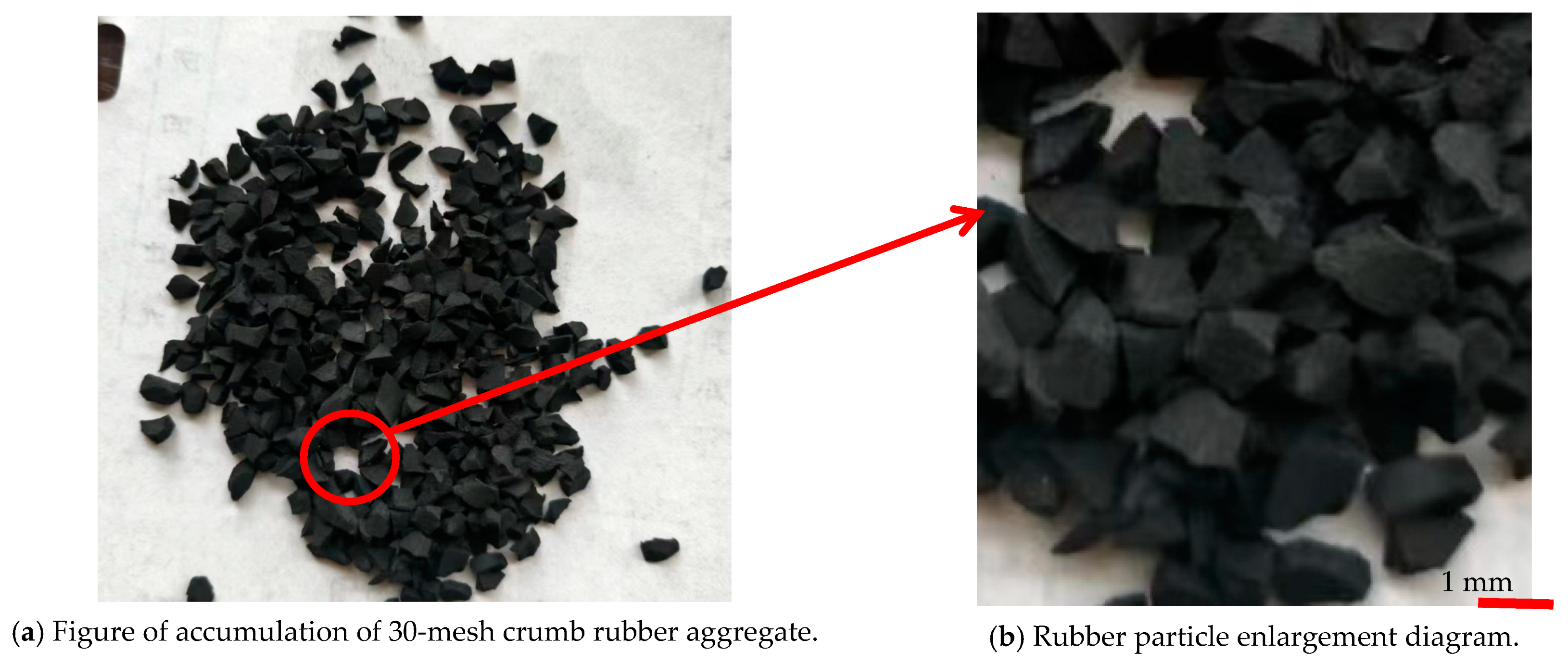
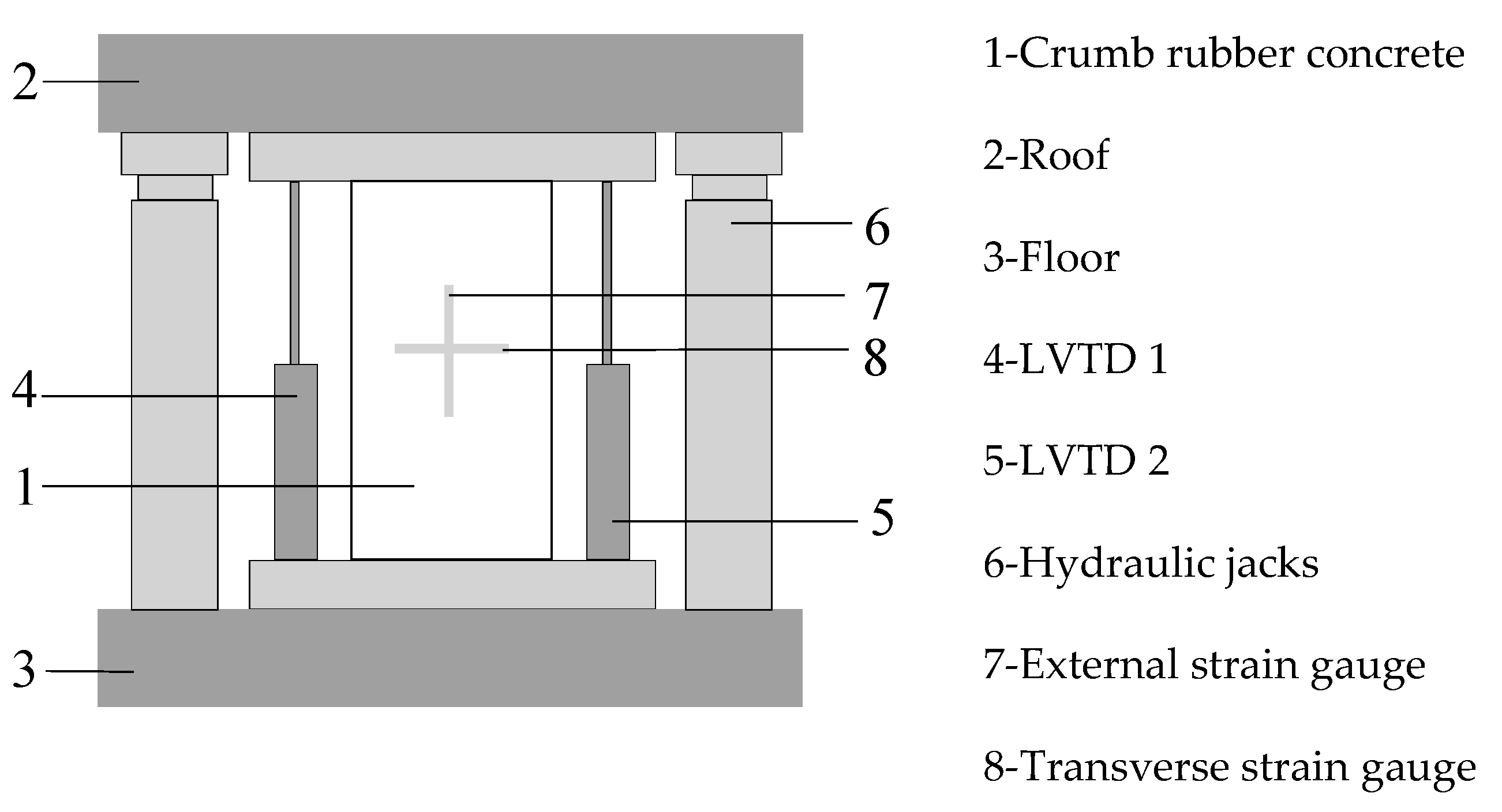

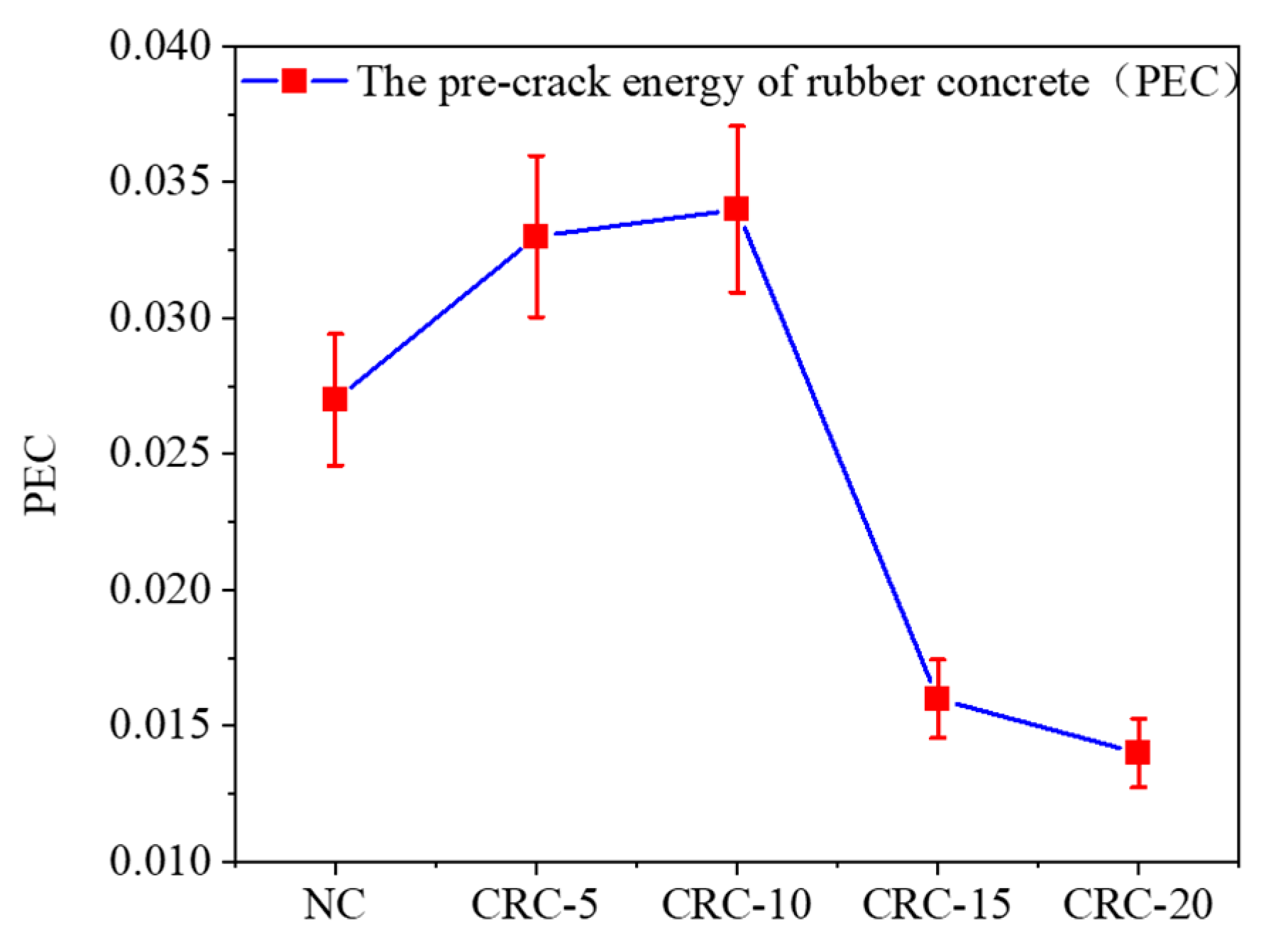
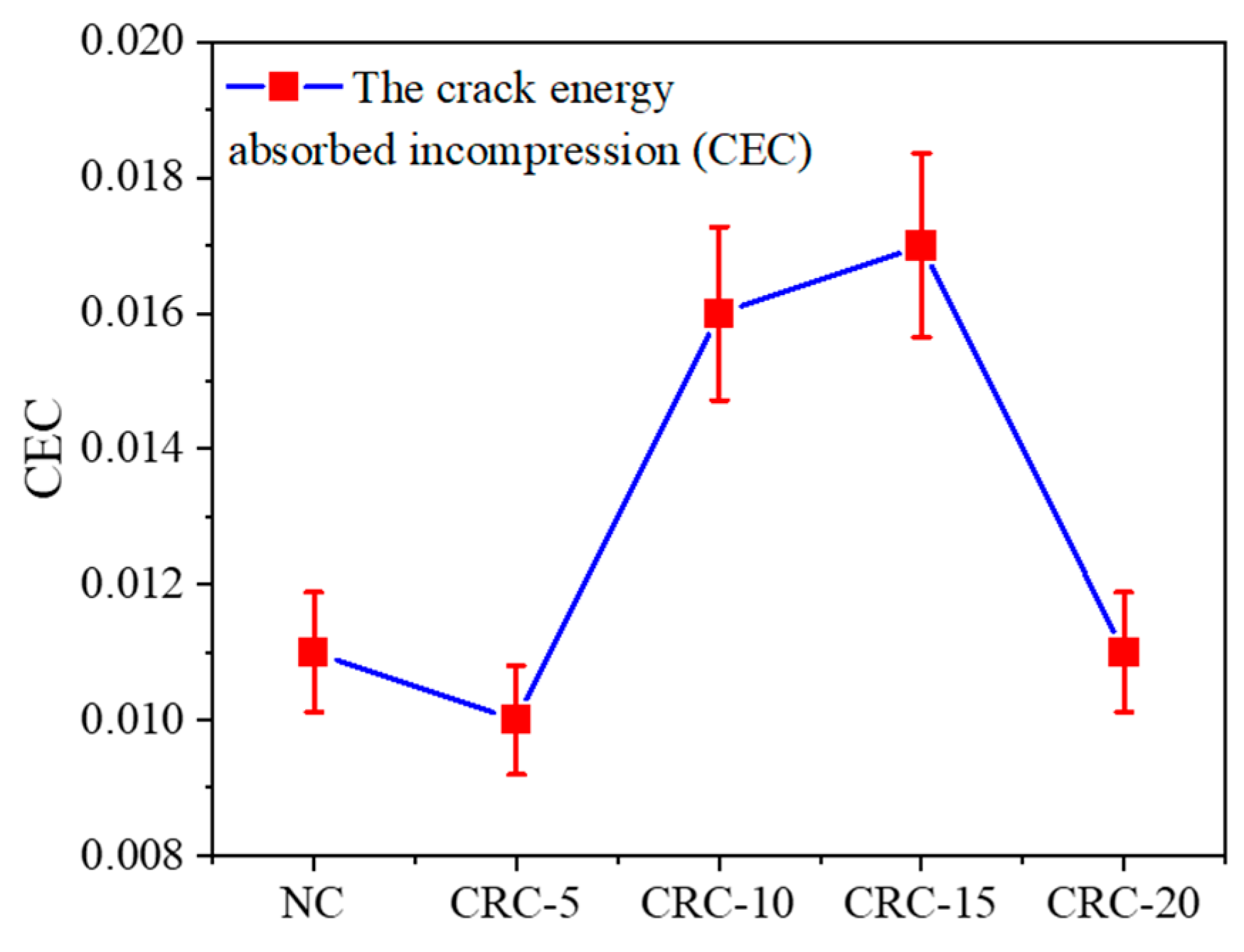
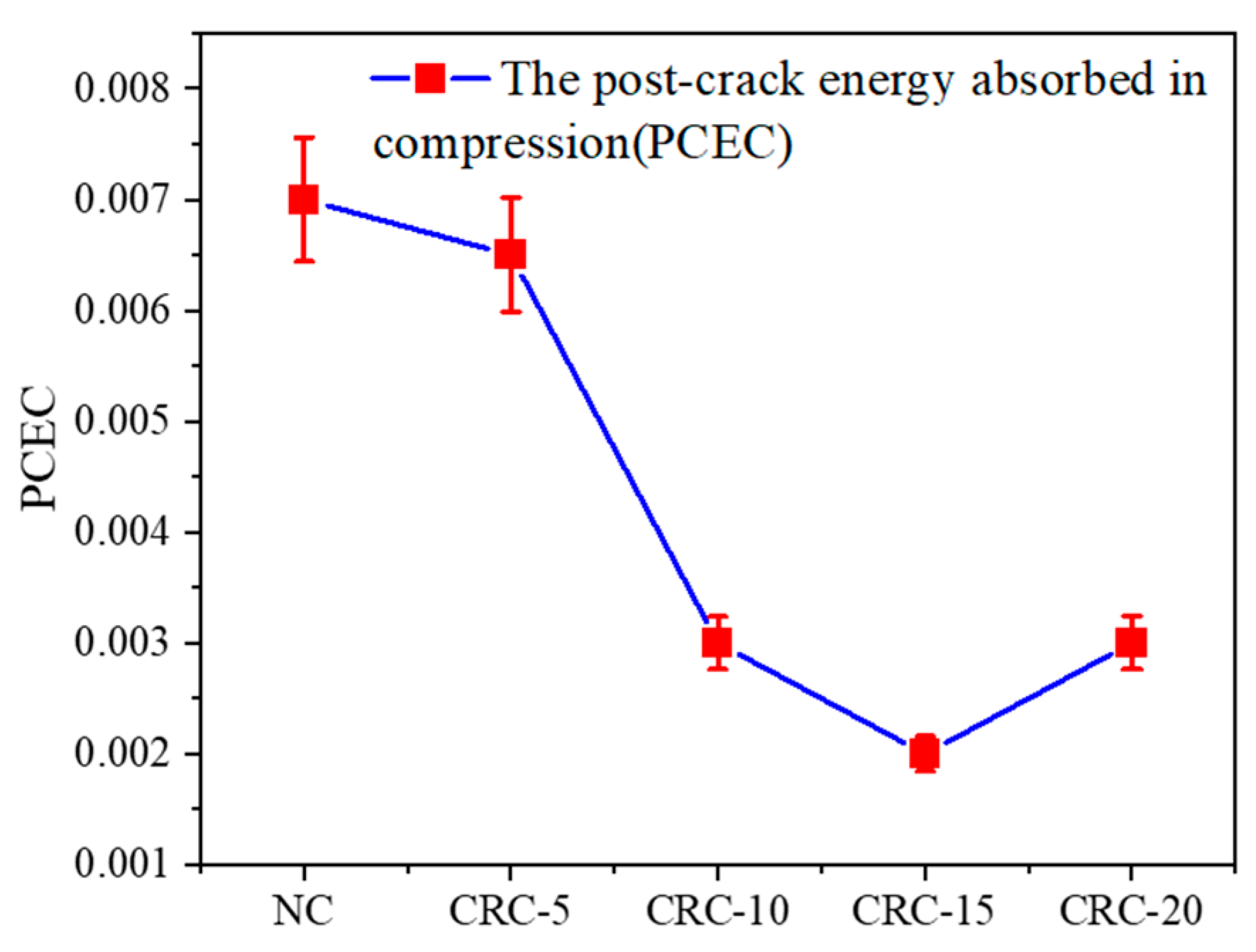
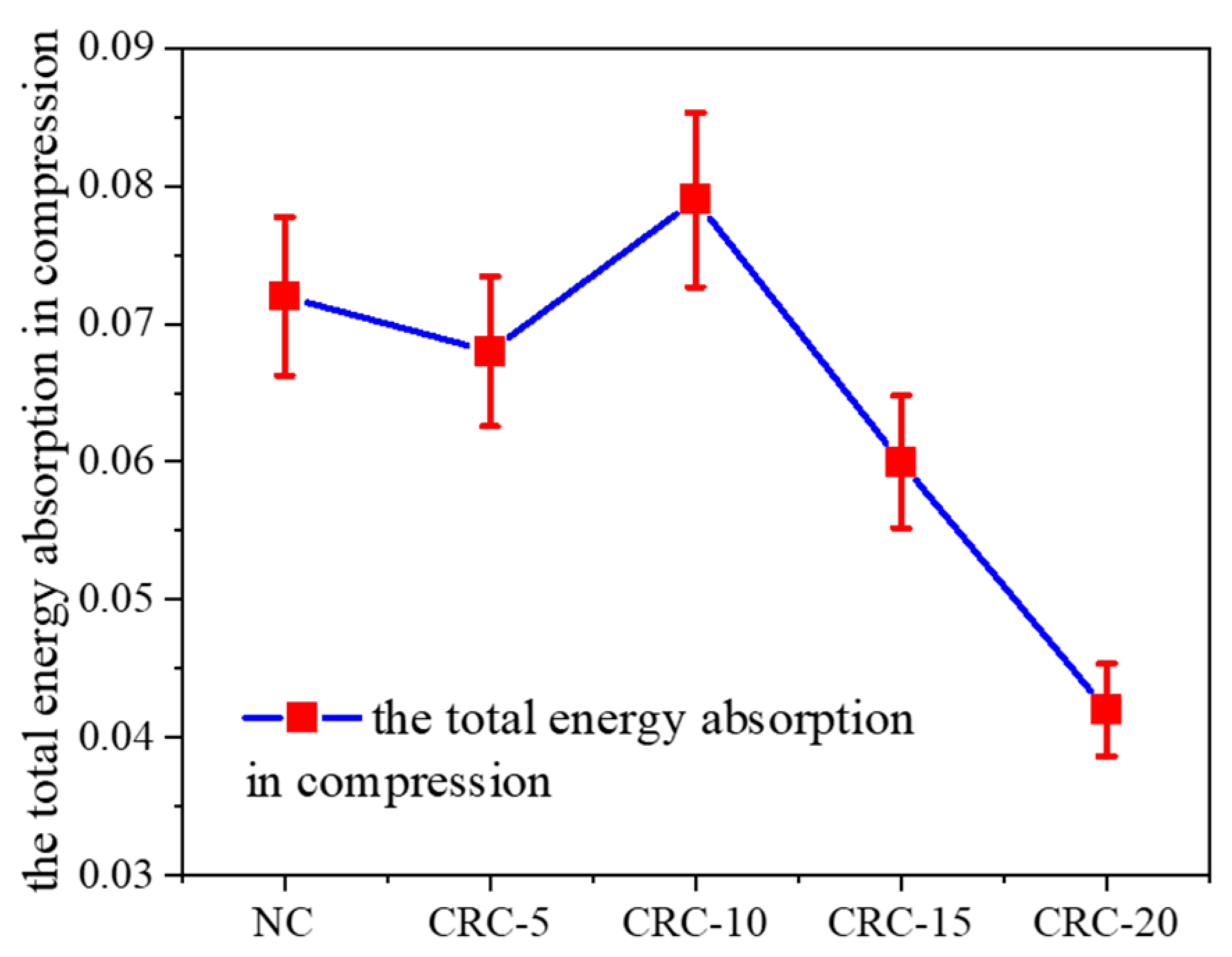
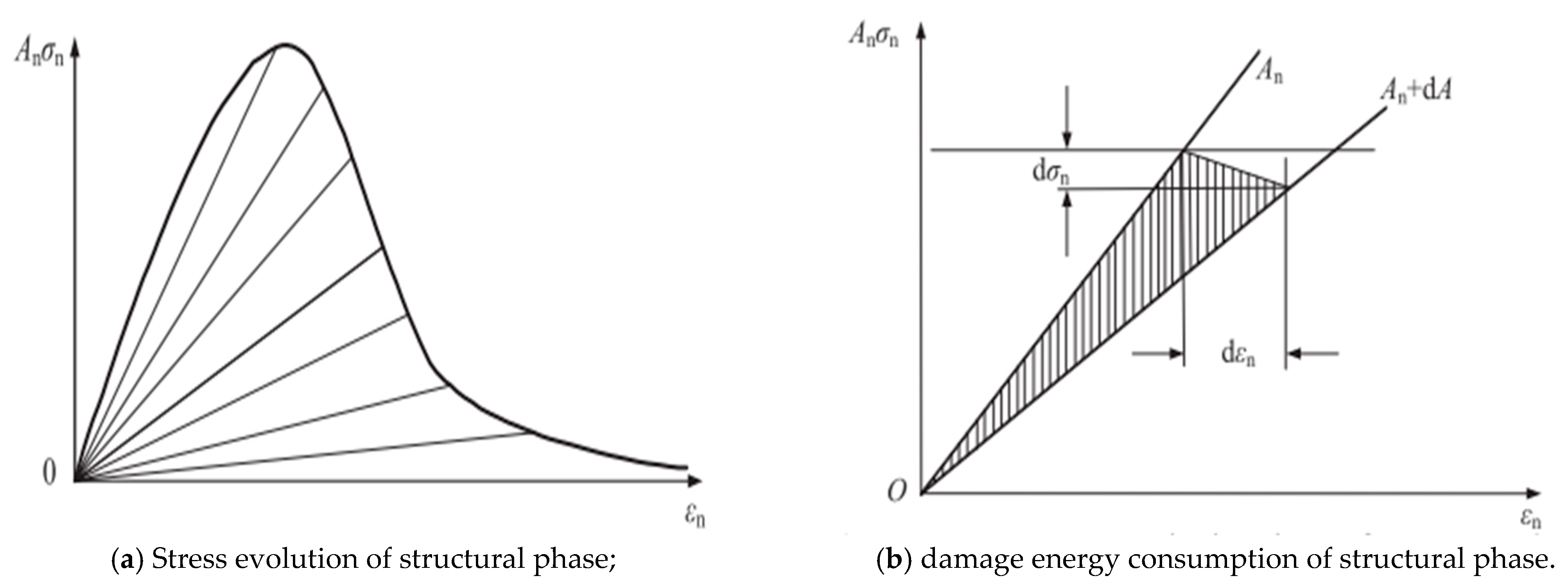

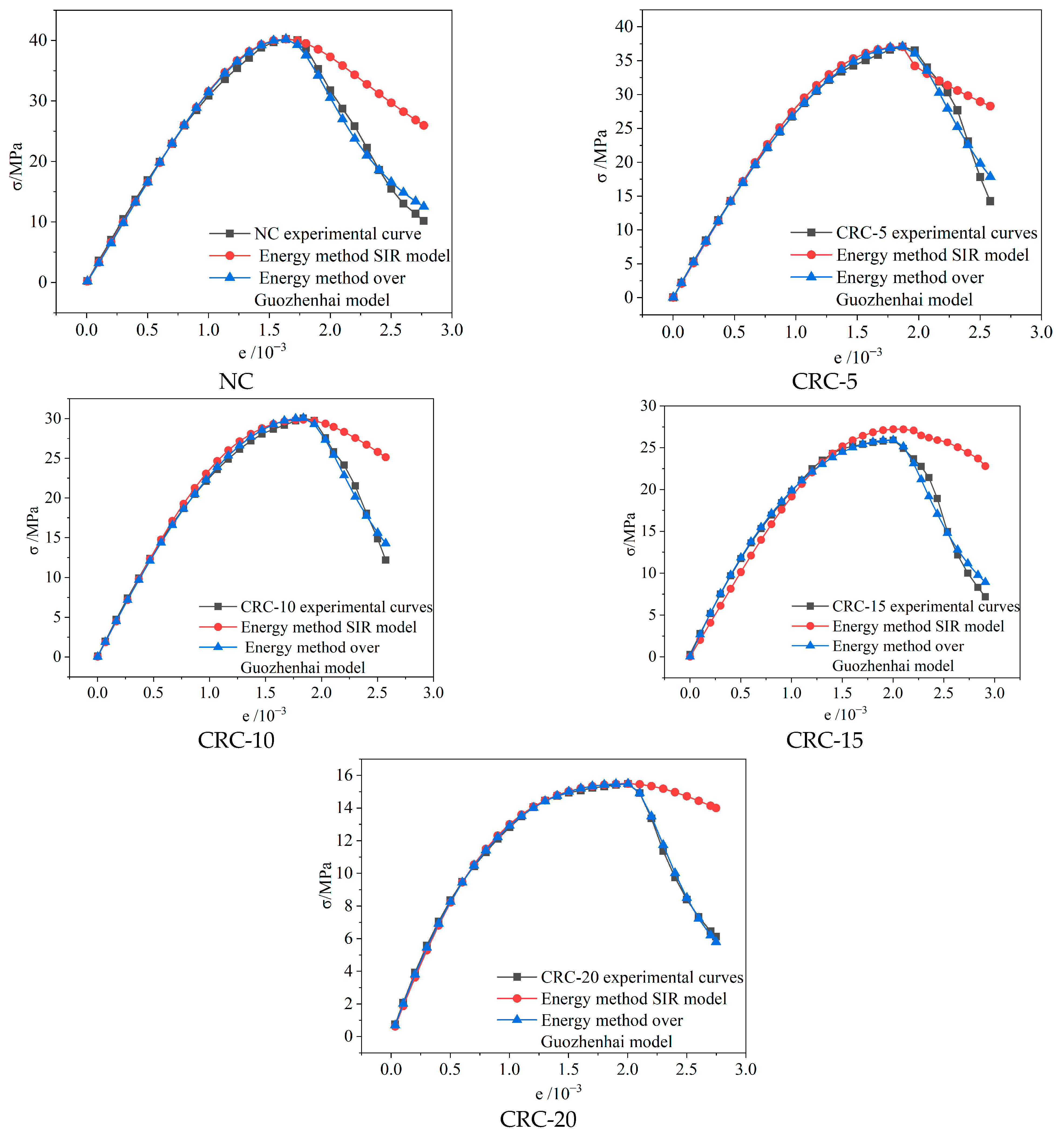

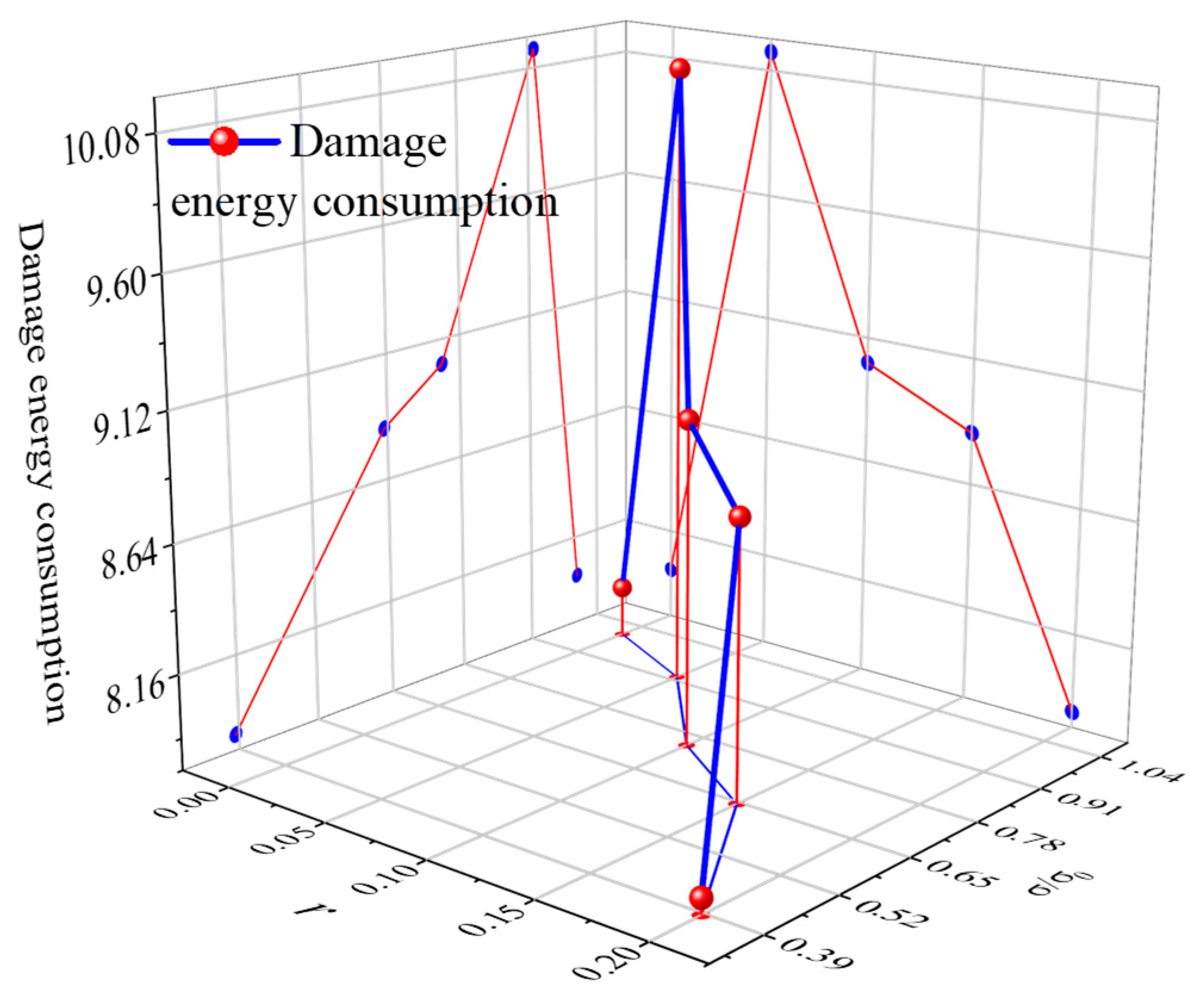
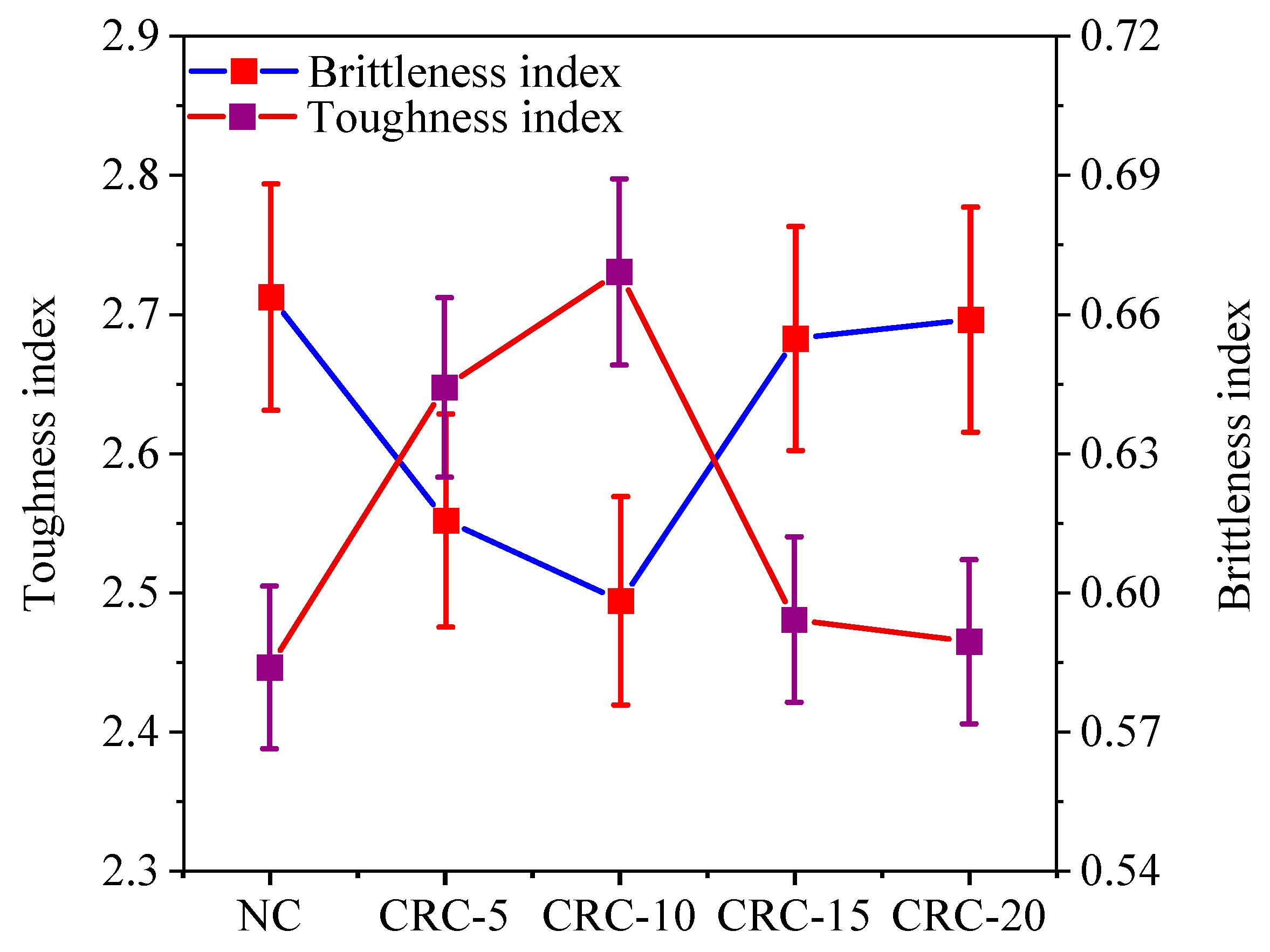
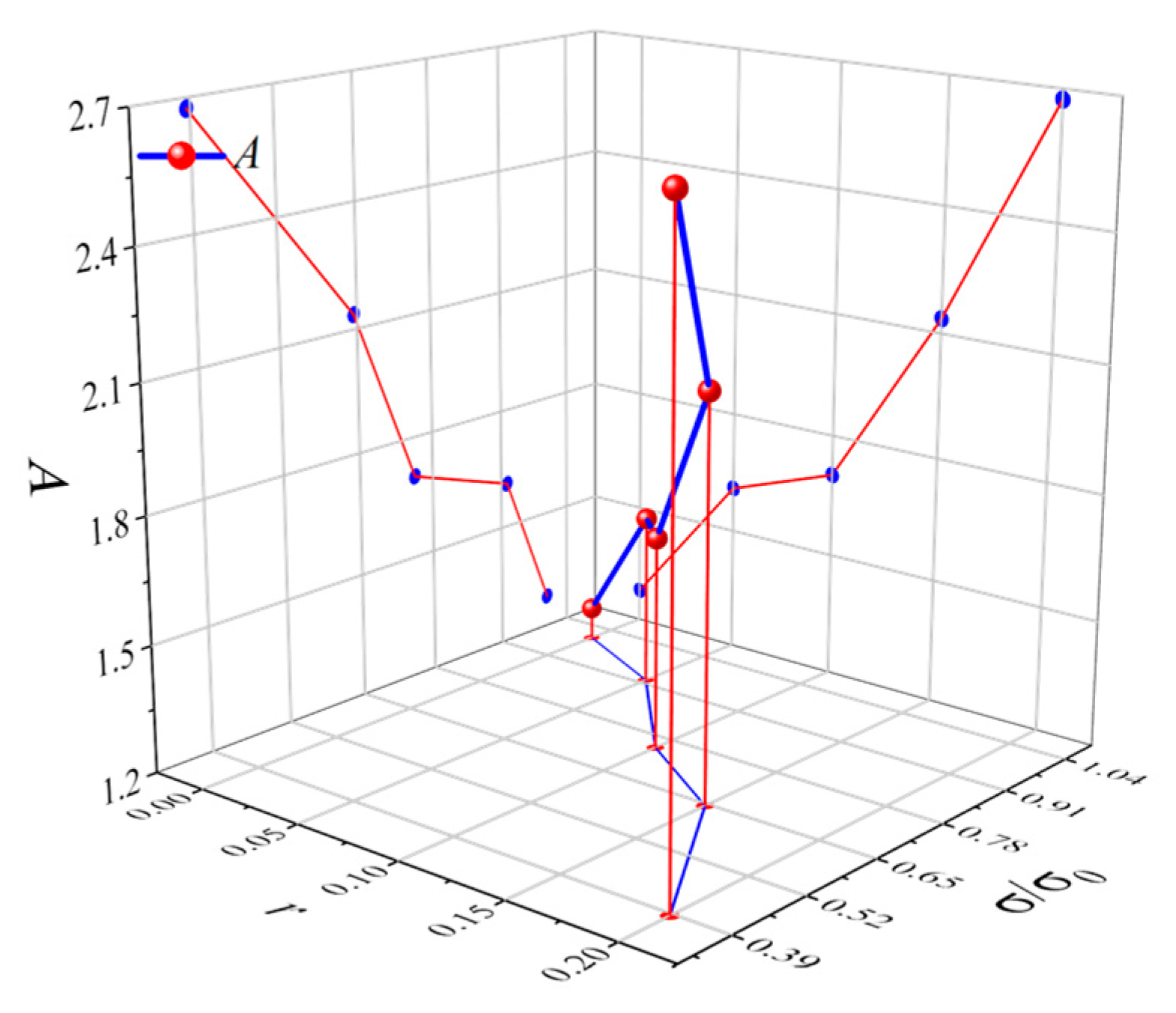


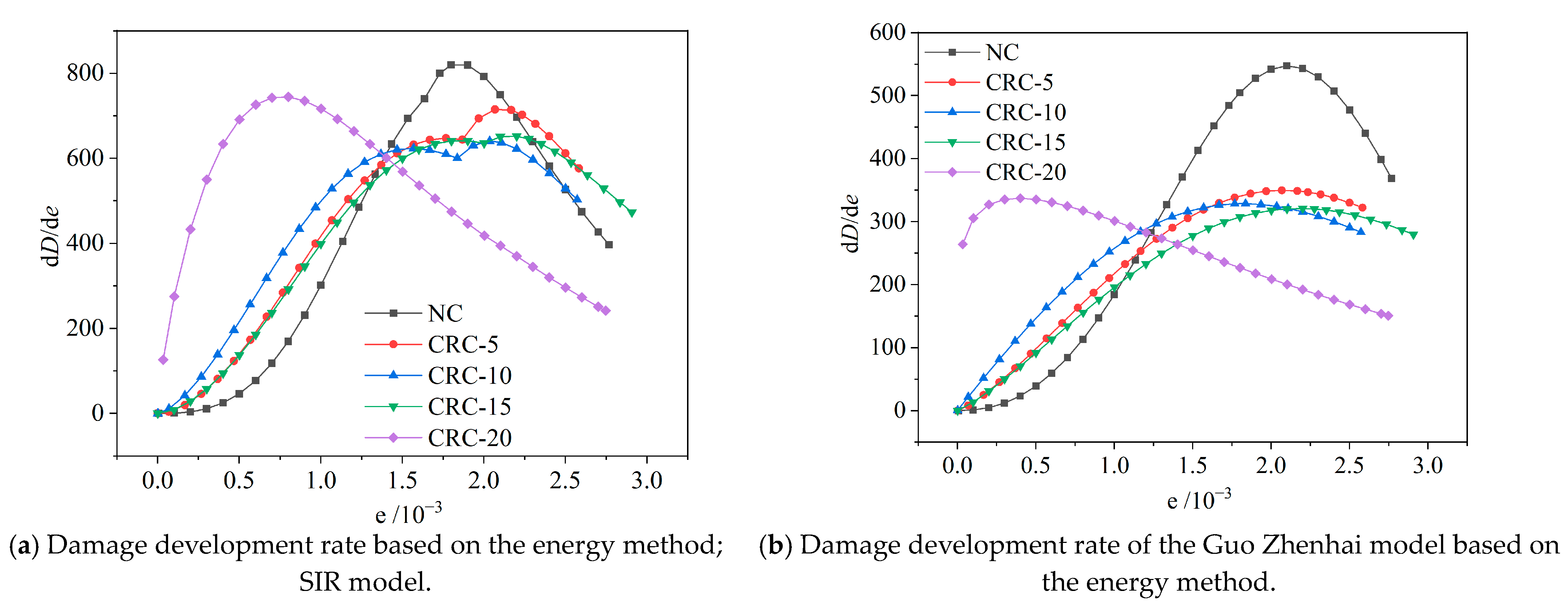
| Apparent Density (kg/m3) | Stability (Boiling Method) | Setting Time (min) | Standard-Consistency Water Consumption (%) | Flexural Strength (MPa) | Compressive Strength (MPa) | |||
|---|---|---|---|---|---|---|---|---|
| Initial Setting | Final Setting | 3d | 7d | 3d | 7d | |||
| 2900 | Qualified | 115 | 255 | 27 | 5.8 | 9.4 | 24.7 | 47.8 |
| Projects | Burning Loss (%) | Fineness (%) | Water Requirement (%) | Apparent Density (kg/m3) | SO3 (%) |
|---|---|---|---|---|---|
| Index | 2.7 | 18 | 93 | 2448 | 2.57 |
| Specimen Number | Rubber Particles | Sand | Water | Cement | Fly Ash | Crushed Stone | Water Reducer |
|---|---|---|---|---|---|---|---|
| NC | 0 | 772 | 154 | 300 | 40 | 1158 | 6.8 |
| CRC-5 | 18.4 | 733.4 | 154 | 300 | 40 | 1158 | 7.5 |
| CRC-10 | 36.8 | 694.8 | 154 | 300 | 40 | 1158 | 7.8 |
| CRC-15 | 55.2 | 656.2 | 154 | 300 | 40 | 1158 | 8.2 |
| CRC-20 | 73.6 | 617.6 | 154 | 300 | 40 | 1158 | 8.8 |
| NC | CRC-5 | CRC-10 | CRC-15 | CRC-20 | |
|---|---|---|---|---|---|
| 0.6 | 0.5 | 0.4 | 0.2 | 0.1 | |
| 0.621 | 0.489 | 0.360 | 0.228 | 0.101 |
| Specimen Number | A | B | |
|---|---|---|---|
| NC | 1.278 | 1.278 | 7.796 |
| CRC-5 | 1.610 | 1.610 | 10.170 |
| CRC-10 | 1.702 | 1.702 | 9.670 |
| CRC-15 | 2.135 | 2.135 | 13.480 |
| CRC-20 | 2.676 | 2.676 | 16.650 |
Disclaimer/Publisher’s Note: The statements, opinions and data contained in all publications are solely those of the individual author(s) and contributor(s) and not of MDPI and/or the editor(s). MDPI and/or the editor(s) disclaim responsibility for any injury to people or property resulting from any ideas, methods, instructions or products referred to in the content. |
© 2024 by the authors. Licensee MDPI, Basel, Switzerland. This article is an open access article distributed under the terms and conditions of the Creative Commons Attribution (CC BY) license (https://creativecommons.org/licenses/by/4.0/).
Share and Cite
Guo, T.; Xue, G.; Fu, B. Axial Compression Damage Model and Damage Evolution of Crumb Rubber Concrete Based on the Energy Method. Buildings 2024, 14, 705. https://doi.org/10.3390/buildings14030705
Guo T, Xue G, Fu B. Axial Compression Damage Model and Damage Evolution of Crumb Rubber Concrete Based on the Energy Method. Buildings. 2024; 14(3):705. https://doi.org/10.3390/buildings14030705
Chicago/Turabian StyleGuo, Tongge, Gang Xue, and Bolun Fu. 2024. "Axial Compression Damage Model and Damage Evolution of Crumb Rubber Concrete Based on the Energy Method" Buildings 14, no. 3: 705. https://doi.org/10.3390/buildings14030705
APA StyleGuo, T., Xue, G., & Fu, B. (2024). Axial Compression Damage Model and Damage Evolution of Crumb Rubber Concrete Based on the Energy Method. Buildings, 14(3), 705. https://doi.org/10.3390/buildings14030705






